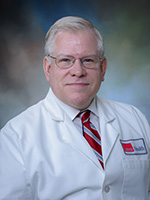Engaging in active hobbies, keeping up with grandchildren, and maintaining physical fitness are important goals for many individuals entering their senior years. But doing so pain-free is not always in the cards.
Paul Dicpinigaitis, MD (aka Dr. “D”) sees patients with this frustrating predicament every day. As a joint replacement specialist in UTMB’s Department of Orthopaedic Surgery and Rehabilitation, he makes it his mission to help patients overcome the pain and limitations of damaged hip and knee joints, so that they can enjoy the active lives they desire.
“The whole idea of joint replacement surgery is to take away as much pain as possible, restore range of motion and function to allow the patient to return to normal activities of daily living,” Dr. Dicpinigaitis says.
A recent addition to the orthopedics team at UTMB, Dr. Dicpinigaitis comes to the department with extensive experience.
He obtained his MD degree at the New York University School of Medicine, then completed his internship at the New York University Medical Center and his residency at the New York University – Hospital for Joint Disease. He completed his fellowship training in adult reconstruction (total hip and knee replacement surgery) at the Florida Orthopaedic Institute in Tampa, Florida.
Dr. Dicpinigaitis’ professional practice includes eight years serving in the United States Air Force, in where he was appointed Chief of Orthopedic Surgery at McGuire Air Force Base in New Jersey. He then went into private practice, with the last 11 years spent in Long Island, NY.
His focus is primary and revision hip and knee replacement surgeries. He has a special interest and training in robotic assisted joint replacement surgery, which he intends to use while performing Mako robotic surgeries at UTMB’s League City Campus. He also has clinical expertise in treating periprosthetic total hip and knee fractures, as well as periprosthetic hip and knee joint infections.
Most patients who are candidates for joint replacements are 50 and older. Joint replacement implants have a limited lifespan – 15 to 20 years on average – so Dr. Dicpinigaitis says the age of the patient is always a consideration when evaluating whether a joint replacement is the right solution.
He says someone who has a replacement surgery at 50 might very well come back for revision surgery by age 70, with the goal being a continued enjoyment of their quality of life.
“In the past, we did not have as much of a knowledge base, refined surgical techniques or cutting-edge technologies available to successfully perform complex revisions. Given the progress that we have made over the years, and despite revisions still being more difficult to perform than primaries, we have gotten a lot better at them,” he says.
The challenges associated with revisions mean that more conservative measures might first be recommended to younger patients. For someone younger than 50 who is considering joint replacement, they may be looking at even more than one revision surgery during their future lifespan. Each subsequent revision surgery becomes more challenging, as the patient is left with less and less of their original bone and soft tissue with which to reconstruct their remaining joint.
Solutions like physical therapy, weight loss, anti-inflammatory medications, or even the possibility of a unicompartmental (or “half knee replacement”), may help delay a younger patient’s need for total joint replacement surgery. Dr. Dicpinigaitis explores these options with patients. As every patient’s situation is unique, his goal is to find the most effective path forward.
Fortunately, Dr. Dicpinigaitis has observed that the lifespan of replacement implants has been increasing as technology and techniques have continued to improve. It is now more common to see patients in the office who are going on 30 years with their original implants still intact and functioning well.
With his arrival at UTMB this past February, he is part of a newly expanded team in Orthopedics dedicated to helping patients find the right solution for their joint pain needs.
With this recent increase in availability and expertise, Dr. Dicpinigaitis is excited to help make UTMB the health system of choice for joint replacement and reconstruction needs.
 | Paul Dicpinigaitis, MD, sees patients at the UTMB Orthopedics Clinics in League City and Clear Lake. Learn more about joint replacement and reconstruction services at UTMB. |
